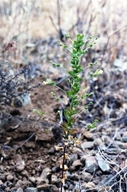Taxon Report
Antirrhinum subcordatum Graydimorphic snapdragon |
 © 2015 Dean Wm. Taylor |
Taxon Summary
Antirrhinum subcordatum, commonly known as dimorphic snapdragon, is a annual herb in the Plantaginaceae that is found only in California. It occurs within Chaparral, and Lower montane coniferous forest, growing at elevations from 185 to 800 meters. Antirrhinum subcordatum is ranked 4.3, Plants of Limited Distribution, A Watch List; Not very threatened in California.Classification
|
Scientific Name: |
Antirrhinum subcordatum Gray |
|
Common Name: |
dimorphic snapdragon |
| Family: | Plantaginaceae |
| Element Code: | PDSCR2S070 |
| USDA Plants Symbol: | |
|
Synonyms/Other Names: |
|
Ecology and Life History
| Lifeform: | annual herb |
| Blooming Period: Apr-Jul | Apr-Jul |
| Elevation: | 185-800 (605-2625) |
| General Habitats: | Chaparral, Lower montane coniferous forest |
| Microhabitat: | Serpentine (sometimes) |
| Microhabitat Details: |
Conservation Status
| CA Rare Plant Rank: | 4.3 |
| Global Rank: | G3 |
|
State Rank: |
S3 |
| State List: | None |
| Fed List: | None |
| Other Status: | USFS_S |
|
CRPR Changes: |
|
Occurrence Data from the CNDDB
| Total Occurrences: | 49 |
| Element Occurrence Ranks: | |
| Excellent (A) | 11 |
| Good (B) | 3 |
| Fair (C) | 4 |
| Poor (D) | 0 |
| None (X) | 1 |
| Unknown (U) | 30 |
| California Endemic: True | |
| California Counties and Islands: Name (Code) | |
| Colusa (COL), Glenn (GLE), Lake (LAK), Tehama (TEH) | |
| Quads: Name (Quad Code) | |
| Chrome (3912265), Cold Fork (4012226), Fouts Springs (3912236), Gilmore Peak (3912235), Hall Ridge (3912276), Highland Springs (3812288), Lodoga (3912234), Lowrey (4012215), Mitchell Gulch (4012234), Newville (3912275), Paskenta (3912285), Raglin Ridge (4012216), Riley Ridge (3912286), Rosewood (4012235), St. John Mtn. (3912246), Stonyford (3912245), Tomhead Mtn. (4012227), Whispering Pines (3812276) | |
Threat List Data from the CNDDB
| Threat List Total: | 6 | |
| EOs with Threat Listed: | Total EOs | % of EOs |
| 19 | 39 % | |
| Grazing | 8 | 16% |
| Other | 8 | 16% |
| Dam/Inundation | 6 | 12% |
| Road/trail construction/maint. | 2 | 4% |
| Recreational use (non-ORV) | 1 | 2% |
| Logging | 1 | 2% |
Selected References
| Proceedings of the American Academy of Arts and Sciences 20:306 (1884) |
| Antirrhinum subcordatum profile for potential Species of Conservation Concern evaluation (2018) |
Citation
California Native Plant Society, Rare Plant Program. 2025. Rare Plant Inventory (online edition, v9.5.1). Website https://www.rareplants.cnps.org [accessed 25 December 2025].